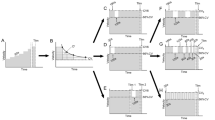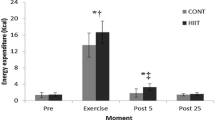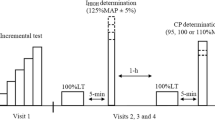Abstract
The aim of this study was to analyze the effects of recovery mode (active/passive) on time spent at high percentage of maximal oxygen uptake \({({V\hbox{O}}_{2{\rm max}})},\) i.e. above 90% of \({{V\hbox{O}}_{2{\rm max}}\;(t{90}{V\hbox{O}}_{2{\rm max}})}\) and above 95% of \({{V\hbox{O}}_{2{\rm max}}}\;(t95{{V\hbox{O}}_{2{\rm max}}})\) during a single short intermittent session. Eight endurance-trained male adolescents (15.9 ± 1.4 years) performed three field tests until exhaustion: a graded test to determine their \({{V\hbox{O}}_{2{\rm max}}}\) (57.4 ± 6.1 ml min−1 kg−1), and maximal aerobic velocity (MAV; 17.9 ± 0.4 km h−1), and in a random order, two intermittent exercises consisting of repeated 30 s runs at 105% of MAV alternated with 30 s passive (IEP) or active recovery (IEA, 50% of MAV). Time to exhaustion (t lim) was significantly longer for IEP than for IEA (2145 ± 829 vs. 1072 ± 388 s, P < 0.01). No difference was found in \({t90{V\hbox{O}}_{2{\rm max}}}\) and \({t95{V\hbox{O}}_{2{\rm max}}}\) between IEP (548 ± 499–316 ± 360 s) and IEA (746 ± 417–459 ± 332 s). However, when expressed as a percentage of t lim, \({t90{V\hbox{O}}_{2{\rm max}}}\) and \({t95{V\hbox{O}}_{2{\rm max}}}\) were significantly longer (P < 0.001 and P < 0.05, respectively) during IEA (67.7 ± 19%–42.1 ± 27%) than during IEP (24.2 ± 19%–13.8 ± 15%). Our results demonstrated no influence of recovery mode on absolute \({t90{V\hbox{O}}_{2{\rm max}}}\) or \({t95{V\hbox{O}}_{2{\rm max}}}\) mean values despite significantly longer t lim values for IEP than for IEA. In conclusion, passive recovery allows a longer running time (t lim) for a similar time spent at a high percentage of \({{V\hbox{O}}_{2{\rm max}}}.\)




Similar content being viewed by others
References
Åstrand I, Åstrand PO, Christensen EH, Hedman R (1960) Intermittent muscular work. Acta Physiol Scand 48:448–453
Abdi H (1987) Introduction au traitement statistique des données expérimentales. Grenoble. Presse Universitaire de Grenoble
Baldari C, Videira M, Madeira F, Sergio J, Guidetti L (2005) Blood lactate removal during recovery at various intensities below the individual anaerobic threshold in triathletes. J Sports Med Phys Fitness 45(4):460–466
Bangsbo J, Gollnick PD, Johansen L, Saltin B (1994) Muscle lactate metabolism in recovery from intense exhaustive exercise: Impact of light exercise. J Appl Physiol 77:1890–1895
Billat V, Bernard O, Pinoteau J, Petit B, Koralsztein JP (1994) Time to exhaustion at VO2max and lactate steady state velocity in sub-elite long-distance runners. Arch Int Physiol Biochem Biophys 102:215–219
Billat VL, Slawinski J, Bocquet V, Demarle A, Lafitte L, Chassaing P, Koralsztein JP (2000) Intermittent runs at the velocity associated with maximal oxygen uptake enables subjects to remain at maximal oxygen uptake for a longer time than intense but submaximal runs. Eur J Appl Physiol 81:188–196
Bogdanis GC, Nevill ME, Lakomy HK, Graham CM, Louis G (1996) Effects of active recovery on power output during repeated maximal sprint cycling. Eur J Appl Physiol 74:461–469
Dorado C, Sanchis-Moysi J, Calbert JAL (2004) Effects of recovery mode on performance, O2 uptake, and O2 deficit during high intensity intermittent exercise. Can J Appl Physiol 29(3):227–244
Dupont G, Berthoin S (2004) Time spent at a high percentage of VO2max for short intermittent runs: active versus passive recovery. Can J Appl Physiol 29(suppl):S3–S16
Dupont G, Blondel N, Berthoin S (2003a) Performance for short intermittent runs: active vs. passive recovery. Eur J Appl Physiol 89:548–554
Dupont G, Blondel N, Berthoin S (2003b) Time spent at VO2max: a methodological issue. Int J Sports Med 24:291–297
Fox E (1975) Differences in metabolic alterations with sprint versus endurance interval training. In: Howald H, Poortmans J (eds) Metabolic adaptation to prolonged physical exercise. Birkha-user, Basel, pp 119–126
Gallagher CG, Hof VI, Younes M (1985) Effect of inspiratory muscle fatigue on breathing pattern. J Appl Physiol 59:1152–1158
Geor RJ, McCutcheon LJ, Hinchcliff KW (2000) Effects of warm-up intensity on kinetics of oxygen consumption and carbon dioxide production during high-intensity exercise in horses. Am J Vet Res 61:638–645
Gerbino A, Ward SA, Whipp BL (1996) Effects of prior exercise on pulmonary gas-exchange kinetics during high-intensity exercise in humans. J Appl Physiol 80:99–107
Gisolfi C, Robinson S, Turrel ES (1966) Effects of aerobic work performed during recovery from exhausting work. J Appl Physiol 21:1767–1772
Gonzalez-Alonso J, Calbet JAL (2003) Reductions in systemic muscle blood flow and oxygen delivery limit maximal aerobic capacity in humans. Circulation 107:824–830
Gorostiaga EM, Walter CB, Foster C, Hickson RC (1991) Uniqueness of interval and continuous training at the same maintained exercise intensity. Eur J Appl Physiol 63:101–107
Harms CA, Badcock MA, McClaran SR, Pegelow DF, Nickele GA, Nelson WB, Dempsey JA (1997) Respiratory muscle work compromises leg blood flow during maximal exercise. J Appl Physiol 82:1573–1583
Hermansen L (1981) Effect of metabolic changes on force generation in skeletel muscle during maximal exercise. In: Ciba Foundation Symposium (C.F.S) (ed) Human muscle fatigue: physiological mechanisms, vol 82. Pitman Medical, London, pp 75–88
Hermansen L, Stensvold I (1972) Production and removal of lactate during exercise in man. Acta Physiol Scand 86:191–201
Hill DW, Rowell AL (1997) Responses to exercise at the velocity associated with VO2max. Med Sci Sports Exerc 29:113–116
Hill DW, Williams CS, Burt SE (1997) Responses to exercise at 92% and 100% of the velocity associated with VO2max. Int J Sports Med 18:325–329
Holloszy JO, Coyle EF (1984) Adaptations of skeletal muscle to endurance exercise and their metabolic consequences. J Appl Physiol 56:831–838
Jones AM, Carter H (2000) The effect of endurance training on parameter of aerobic fitness. Sports Med 29(6):373–386
Jones NL, Sutton JR, Taylor R, Toews CJ (1977) Effect of pH on cardiorespiratory and metabolic responses to exercise. J Appl Physiol 43:959–964
Jones AM, Koppo K, Burnley M (2003) Effects of prior exercise on metabolic and gas exchange responses to exercise. Sports Med 33:949–971
Kuipers H, Verstappen FT, Keizer HA, Geurten P, van Kranenburg G (1985) Variability of aerobic performance in the laboratory and its physiologic correlates. Int J Sports Med 6:197–201
MacDonald MJ, Pedersen PK, Hughson RL (1997) Acceleration of VO2 kinetics in heavy submaximal exercise by hyperoxia and prior high-intensity exercise. J Appl Physiol 83:1318–1325
McLaughlin JE, King GA, Howley ET, Bassett DR Jr, Ainsworth BE (2001) Validation of the COSMED K4 b2 portable metabolic system. Int J Sports Med 22:280–284
Metzger JM and Fitts RH (1987) Role of intracellular pH in muscle fatigue. J Appl Physiol 62:1392–1397
Midgley AW, McNaughton LR (2006) Time at or near VO2max during continuous and intermittent running: A review with special reference to considerations for the optimization of training protocols to elicit the longest time at or near VO2max. J Sports Med Phys fitness 46:1–14
Millet GP, Candau R, Fattori P, Bignet F, Varray A (2003a) VO2 responses to different intermittent runs at velocity associated with VO2max. Can J Appl Physiol 28:410–423
Millet GP, Libicz S, Borrani F, Fattori P, Bignet F, Candau R (2003b) Effects of increased intensity of intermittent training in runners with differing VO2 kinetics. Eur J Appl Physiol 90:50–57
Nielsen HB, Hein L, Svendsen LB, Secher NH, Quistorff B (2002) Bicarbonate attenuates intracellular acidosis. Acta Anaesthesiol Scand 46:579–584
Noakes TD (1991) Lore of running. Leisure Press, Champaign, IL, p 450
Perrey S, Candau R, Millet GY, Borrani F, Rouillon JD (2002) Decrease in oxygen uptake at the end of a high-intensity submaximal running in humans. Int J Sports Med 23:298–304
Robinson DM, Robinson SM, Hume PA, Hopkins WG (1991) Training intensity of elite male distance runners. Med Sci Sports Exerc 23:1078–1082
Sahlin K (1983) Effect of acidosis on energy metabolism and force generation in skeletel muscle. In: Knuttgen HG, Vogel JA, Portmans JR (eds) Biochemistry of exercise V. Human Kinetics, Champaign, pp 151–160
Septo NK, Hawley JA, Dennis SC, Hopkins WG (1999) Effects of different interval-training programs on cycling time-trial performance. Med Sci Sports Exerc 31:736–741
Signorile JF, Ingalls C, Tremblay LM (1993) The effects of active and passive recovery on short-term, high-intensity power output. Can J Appl Physiol 18:31–42
Spiro SG (1977) Exercise testing in clinical medicine. Br J Dis Chest 71:145–172
Stackhouse SK, Reisman DS, Binder-Macleod SA (2001) Challenging the role of pH in skeletal muscle fatigue. Phys Ter 81:1897–1903
Sutton JR, Jones NL, Toews CJ (1981) Effect of pH on muscle glycolysis during exercise. Clin Sci 61:331–338
Tabata I, Nishimura K, Kouzaki M, Hirai Y, Ogita F, Miyachi M, Yamamoto K (1996) Effects of moderate-intensity endurance and high-intensity intermittent training on anaerobic capacity and VO2max. Med Sci Sports Exerc 28:1327–1330
Tardieu-Berger M, Thevenet D, Zouhal H, Prioux J (2004) Effects of active recovery between series on performance during an intermittent exercise model in young endurance athletes. Eur J Appl Physiol 93:145–152
Taylor H, Buskirk E, Henschel A (1955) Maximal oxygen intake as an objective measure of cardiorespiratory performance. J Appl Physiol 8:73–80
Wasserman K, Hansen JE, Sue DY, Whipp BJ, Casaburi R (1994) Principle of exercise testing and interpretation, 2nd edn. Lea and Febiger, Philadelphia, pp 126–127
Wenger HA, Bell GJ (1986) The interactions of intensity, frequency and duration of exercise training in altering cardiorespiratory fitness. Sports Med 3:346–356
Whipp B, Ward S, Wasserman K (1984) Ventilatory responses to exercise and their control in man. Am Rev Respir Dis 129(2pt2):S17–S20
Acknowledgments
The authors would like to thank the “Plateau Technique de Médecine du Sport” of Laval (France) for there technical assistance. We would also like to acknowledge the financial support of the “Direction Departmental de la Jeunesse et des Sports” of Loire Atlantique (France).
Author information
Authors and Affiliations
Corresponding author
Rights and permissions
About this article
Cite this article
Thevenet, D., Tardieu-Berger, M., Berthoin, S. et al. Influence of recovery mode (passive vs. active) on time spent at maximal oxygen uptake during an intermittent session in young and endurance-trained athletes. Eur J Appl Physiol 99, 133–142 (2007). https://doi.org/10.1007/s00421-006-0327-1
Accepted:
Published:
Issue Date:
DOI: https://doi.org/10.1007/s00421-006-0327-1




